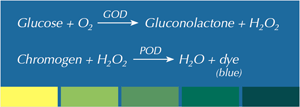Urine Diagnostics / Urine Test Strips / Portfolio Urine Test Strips / Glucose
back to portfolio
| Test principle | |
 |
Glucose is shown on an indicator system by a specific enzymatic reaction for glucose (glucose oxidase: GOD and peroxidase: POD). |
|
In the first step of the reaction glucose is oxidised by atmospheric oxygen and catalysed by GOD to D-gluconolactone. In the second step, the chromogen is oxidated by hydrogen peroxide (under PODCanalysis) to form a dye (colour development from yellow (normal) to green to dark green-blue). |
|
| Sensitivity | ||||||
|
The practical sensitivity for ascorbic acid free urines is approx. 40 mg/dl (2.2 mmol/l). The physiological limit value is around 15 mg/dl, (0.8 mmol/l).
|
|
Specificity |
|
The test is based on the glucose specific glucose oxidase/ peroxidase reaction. Other sugars do not react. Ketone bodies do not interfere. |
|
Sources of error |
|
Ascorbic acid in high doses can hamper the reaction in specimens with a low glucose content (up to 250 mg/dl) and so produce diminished results. In case of a positive ascorbic acid reaction the test should be repeated a day after reducing the vitamin-C intake. Falsepositive results can be caused by oxidising disinfectants. Gentisic acid or pH<5 can delay the colouration. High specific weight reduces the gravity to glucose. |
|
Clinical significance |
|
Apart from arterial sclerosis, diabetes is one of the most important common diseases. Early diagnosis and thus early treatment is of decisive importance, in order to delay or prevent subsequent consequences. Without doubt, it is advantageous if the exceeding of the clinical decision range is accompanied by a clear change in colour, e.g. from yellow to green, as diabetics are often found to have weak eyesight. Within the important diagnostical decision-making range between normal and pathological a good semi-quantitative evaluation is achieved with the first comparison field, which is set to a value of 50mg/dl. |
Before you fill out the form and submit, please read our privacy policy!